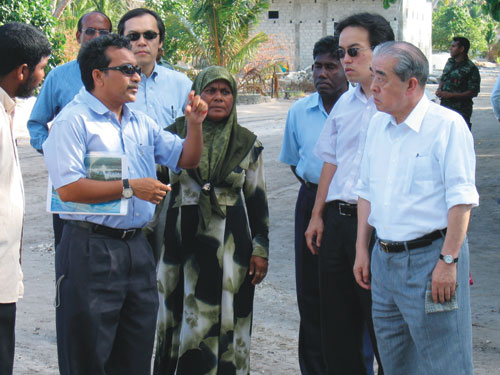Japan's Official Development Assistance White Paper 2005
Main Text > Part II ODA DISBURSEMENTS IN FISCAL YEAR 2004 > Chapter 2 Details and New Policies about Japan's ODA: Striving for Further ODA Reforms > Section 3. Assistance for Each Region > 2. South Asia
2. South Asia
Japan's bilateral ODA to South Asia in 2004 was approximately US$342.66 million, 5.8% of total bilateral ODA.
South Asia is one of the poorest regions in the world with 4 LDCs and over 500 million people living in poverty. In addition to the poverty and population issues, the region is also plagued by low rates of primary school enrollment, inadequate health and medical care, and infectious diseases. Along with Africa, it poses the greatest challenges to the international community regarding the achievement of the MDGs. There are countries in this region faced with the challenges of establishing the rule of law, improving management of public finances, combating corruption, and promoting efficient and transparent administration. Therefore, in order to effectively reduce poverty in this region in the future, it is important to promote good governance in these countries and ensure appropriate institutions and policy environments for receiving assistance. Furthermore, from the viewpoint of the issue of weapons of mass-destruction and missiles in India and Pakistan and the fight against terrorism in the wake of the September 11 terrorist attacks, the international community including Japan has been paying particular attention to this region.
Chart 27. Japan's Assistance Disbursements in the Southwest Asian Region

On the basis of the ODA Charter, which puts poverty reduction as one of four priority issues, Japan will continue to place great importance on dealing with the poverty issue in this region and support desirable activities, including economic deregulation in each country and regional economic cooperation, which promote stability and development of the region.
Regarding assistance for poverty reduction and for ensuring the livelihood of the poor, LDCs like Bangladesh, Bhutan, Nepal, and Maldives in particular are considered priority target countries for grant aid cooperation. Japan is providing cooperation to these countries that places emphasis on BHN sectors such as agriculture, living environments, and health and medical care, while coordinating with technical cooperation.

Senior Vice-Minister for Foreign Affairs Tanigawa visiting Maldives to inspect the damage from the tsunami
Moreover, Japan is providing support for human resources development and social and economic infrastructure development intended to revitalize private-sector activities and create a more attractive environment for foreign investment. With regard to human resources development through technical cooperation, assistance has thus far been carried out mainly in Nepal, Bangladesh, and Sri Lanka, and its scope has recently been expanded to also cover Pakistan. Assistance through yen loans and grant aid are provided for developing economic infrastructures such as electricity and transportation that will improve trade and investment environments, and social infrastructures such as education, water supplies, and sewerage systems. For example, in India, which has received the greatest amount of yen loans in FY2003 and FY2004, the following projects are being implemented through yen loans: the North Karanpura Super Thermal Power Project (I) to resolve the serious electrical power shortage, the Delhi Mass Rapid Transport System Project (VI) to tackle the worsening traffic congestion problem and air pollution in the capital city of New Delhi, and the Ganga Action Plan Project (Varanasi) to help improve the water quality of the Ganges River by enhancing the treatment capacities of the sewerage facilities in the greatest Hindi holy site, Varanasi, Uttar Pradesh. Also, to Pakistan, Japan provided yen loans of up to about 16.4 billion yen in August, 2005, for the Lower Chenab Canal System Rehabilitation Project and the Load Dispatch System Upgrade Project.
Column 9 Japan's Sericulture Technology Woven into Saris
Regarding assistance for the northern and eastern parts of Sri Lanka, the Tokyo Conference on Reconstruction and Development of Sri Lanka was held in June 2003. At this conference, donor countries and agencies expressed their intent to extend over US$4.5 billion over four years. Japan also announced that it is prepared to extend a maximum of US$1 billion over three years depending on the progress of the peace process, and approximately US$400 million had already been provided by FY2004. While no peace talks have taken place since the sixth session, which was held in Hakone in March 2003, ceasefire agreements continued to be honored. From the standpoint of promoting the peace process, Japan is implementing such projects as the Vavuniya-Kilinochchi Transmission Line Project with the objective of improving the living standards of residents in the northern region.


 Next Page
Next Page